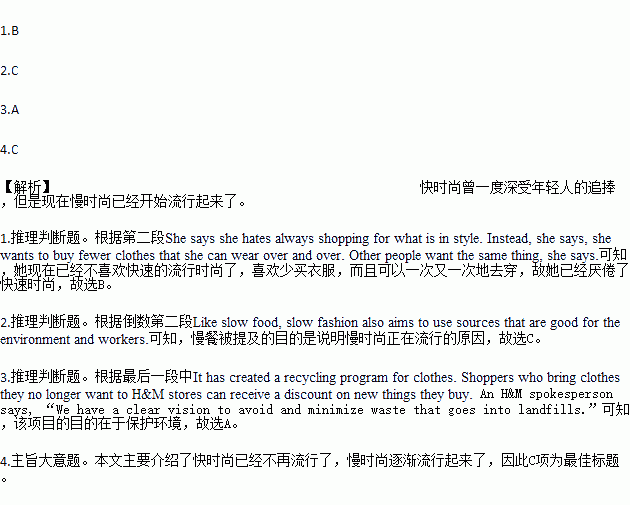题目内容
“Fast fashion” means clothes that are inexpensive but look like the latest designs. One reason for the success of fast fashion is social media. A report by the investment research firm Bernstein found that Millennials—people born in the 1980s and 90s—wanted to wear a variety of clothes in the photos they posted on Facebook, Instagram and Twitter. As a result, many businesses that offer trendy, low-cost clothes are growing.
But the situation is changing now. Maxine Bédat, a woman who is in her early 30s, looks in her closet full of clothes, but she has nothing to wear. She says she hates always shopping for what is in style. Instead, she says, she wants to buy fewer clothes that she can wear over and over. Other people want the same thing, she says.
So Ms. Bédat and a business partner, Soraya Darabi, started a “slow fashion” clothing company called Zady. “Slow fashion” means clothes that last a long time. They are often classic colors and shapes, and are made from natural materials that are biodegradable over time.
The terms “fast fashion” and “slow fashion” are related to “fast food” and “slow food”: fast food is still popular in the U. S. , but many restaurants increasingly offer higher-quality, more expensive and relaxed meals.
Like slow food, slow fashion also aims to use sources that are good for the environment and workers. Maxine Bédat says people in her generation want to know where their clothes come from and who is making them. To answer Millennials’ demand for information about the products they buy, Ms. Bédat’s company, Zady, includes details about the history of the brands. It also describes the process in which the clothes are made. Ms. Bédat says Zady aims to tell shoppers where their clothes come from, where they go, and how they impact the world.
The international business “H&M” is answering Millennials’ demands in another way. It has created a recycling program for clothes. Shoppers who bring clothes they no longer want to H&M stores can receive a discount on new things they buy. An H&M spokesperson says, “We have a clear vision to avoid and minimize waste that goes into landfills.”
1.What’s the attitude of some Millennials towards fast fashion now?
A. Crazy. B. Tired. C. Supportive. D. Doubtful.
2.“Slow food” is mentioned in the text to tell us ________.
A. it is better than fast food B. it is the healthiest food
C. why slow fashion comes now D. why people like fast fashion
3.What can be learned from the program of H&M in the last paragraph?
A. It can help the environment. B. It does good to people’s health.
C. It can help change people’s lives most. D. It will take the lead in the latest fashion.
4.What is the best title of the text?
A. What Is out of Fashion B. Fast Fashion Is Not Fast
C. Slow Fashion Is in Fashion. D. Fast Fashion, Good or Bad

